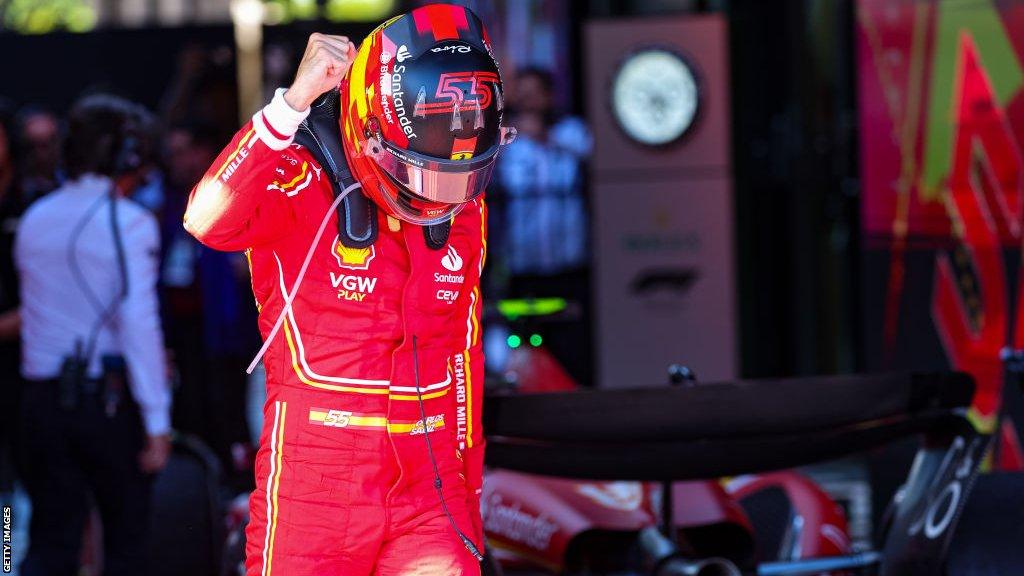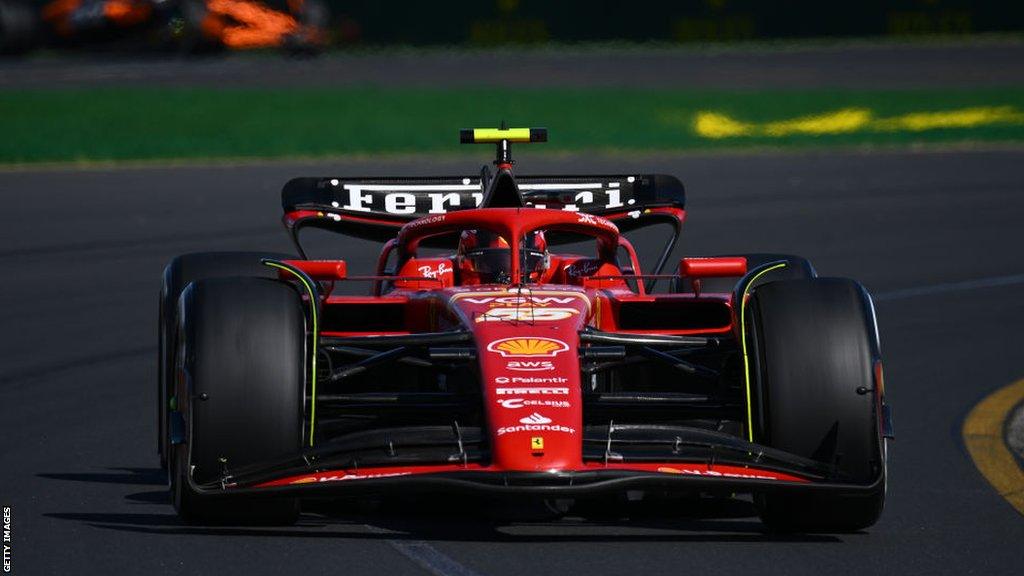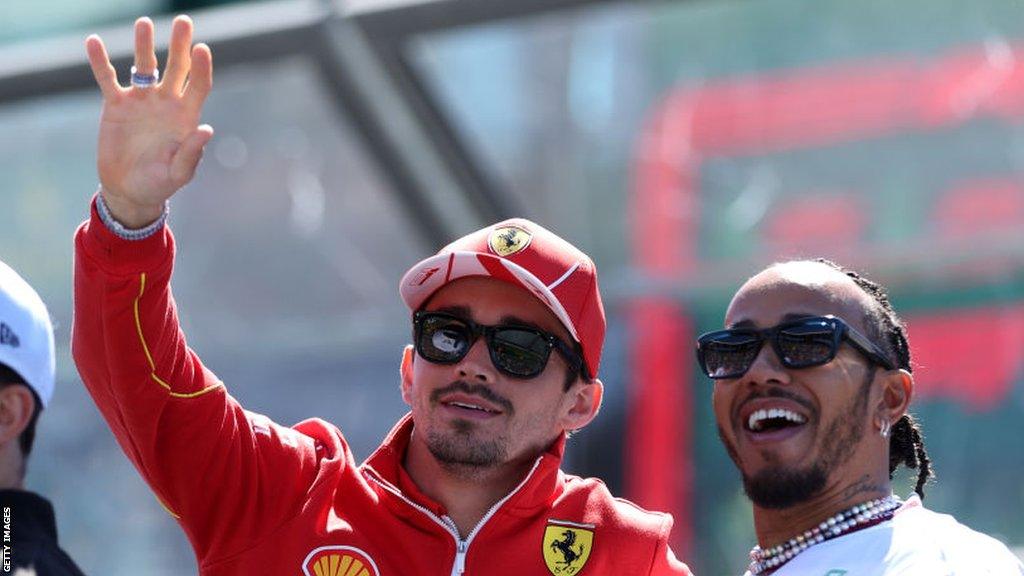'Formula 1 needed a feel-good story, and Carlos Sainz provided it'
- Published

Carlos Sainz is the son of two-time world rally champion Carlos Sainz Sr
Formula 1 probably needed a feel-good story after a tumultuous start to the season off track and Red Bull's continued domination on it, and Carlos Sainz and Ferrari certainly provided it in Australia on Sunday.
The twin controversies revolving around the accusations regarding Red Bull team principal Christian Horner's behaviour towards a female employee, and FIA president Mohammed Ben Sulayem's interference in race operations, have very much not gone away - they dominated conversations in the Melbourne paddock over the weekend.
But a victory for Sainz - and with it a story of redemption and recovery - was a welcome change after two crushing Max Verstappen victories in the opening races that had provided little hope for a competitive season.
Sainz and his team-mate Charles Leclerc, who completed Ferrari's first one-two since the opening race of the 2022 season, were the fastest men on track from the first day of practice at Albert Park.
And while Verstappen took pole, the feeling among rivals before the grand prix was that he was for once not going to have it all his own way. "For Max, it will be the most uncertain race for some time," a rival team boss said on Sunday morning.
That remark was a reference to the relative pace of the Ferrari and Red Bull, and particularly to Ferrari's apparent advantage in tyre usage. But that never got a chance to play out - Verstappen lost the lead to Sainz midway around the second lap and was out just two laps later with his right rear brake on fire.
Sainz's victory prevented Verstappen from matching the all-time record he set last year of 10 consecutive wins - a run that started after Sainz's triumph in Singapore last September, when he became the only non-Red Bull driver to win a race in 2023.
The 29-year-old Spaniard is now the only man to beat Red Bull to a grand prix victory since Mercedes' George Russell won in Brazil on 13 November 2022, a quite extraordinary statistic.
More impressive even than that, though, was the fact that it came just 16 days after he had abdominal surgery following an appendicitis diagnosis that forced him to miss the last race in Saudi Arabia.
And as if that wasn't enough, this was a man who went into the season knowing that Ferrari had decided he was surplus to requirements, following their decision to sign Lewis Hamilton for 2025.
As Sainz put it: "Life sometimes is crazy, you know? It's not only the last two weeks. It's the whole start to the year in general, how the year started with the news of the non-renewal.
"Then you get yourself fit. You get yourself ready for the start of the season, pushing flat out. And then you get to [the first race in] Bahrain. You do a good podium. You say, 'OK, now the season is starting well and I can keep the momentum going.' And suddenly, boom, you're missing a race in Jeddah and the operation.
"Long days in bed, not knowing if I was going to be back in time. Obviously, a lot of unknowns.
"Am I going to be back fit? Am I going to be back feeling still good with the car? And then suddenly you come back and win.
"So, yes, life is a rollercoaster sometimes, but it can be really nice and good to you."
A win despite feeling 'weird'
To go from an operation to a grand prix victory in such a short time is both remarkable and entirely typical of the sort of things F1 drivers do.
Sainz said he had done everything he could to recover quickly, including "going to hyperbaric chambers twice a day for one hour, taking an Indiba machine, that is an electromagnetic thing for the wounds", altering his diet and more.
He had talked about feeling "weird" in the car following his operation. He had no pain, he said, but "everything in the inside just feels like it's moving more than normal and you need some confidence to brace the core and the body as you used to do before".
That meant a race distance was an unknown, but while the feeling persisted, he said, and he felt "very stiff" towards the end, it was "nothing that was slowing me down at all - I was confident with the car and pushing".
It was a crushing performance, of the sort that more normally these days is produced by Verstappen.
Sainz said: "It's what we've said from the beginning - if you are there and you can put Red Bull under pressure, you can sometimes get it done. But you need to be there, and we need to be there more often if we want to win.
"Our car really worked really well this weekend. But I think it's going to be tough to keep it up there in every track until we bring an upgrade to close that gap that we saw in Bahrain and Jeddah.
"But around Australia, from lap one, it felt like a race-winning car. And even if Red Bull were also quick and were on pole, that [lap time] wasn't out of reach for us.
"There will be tracks where we are strong, like we saw last year. And this year it seems like our race pace is better even on those tracks that we are stronger. And together with a good development programme, I hope that we can challenge Red Bull more often."

Sainz took his third career win on Sunday
Is this the start of a Ferrari revival?
It would be too early to suggest that it is the start of a season in which Ferrari can now take the fight to Red Bull. The world champions knew they had a fight going into this particular race, but there was not enough evidence to know how it would have unfolded without Verstappen's problems.
Red Bull said his retirement was caused by a caliper causing the brake to bind on to the disc. The word up and down the pit lane was that this had been caused by the mechanics not properly doing up the bolts after a post-qualifying check. Red Bull said they would not know before fully analysing the car and data.
The pace of Verstappen's team-mate Sergio Perez on his way to fifth place suggested, as Ferrari team boss Frederic Vasseur said, that "you could imagine it would have been possible" even with the Dutchman in the race.
But as Vasseur also said, "sometimes the gap between Max and Checo is big", and in this case from mid-race Perez had a visor tear-off caught in his car's floor that disrupted the underbody airflow and cost about 0.2 seconds a lap.
This performance was, though, certainly proof of the good work Ferrari have done over the winter, particularly on their race pace.
Vasseur said: "Where we made a huge step is more on the consistency between the two (tyre) compounds or between one stint and the other one. The car is much easier to drive, much easier to read for the drivers."
This does not only help in race preparation, making the practice days run a lot smoother than they were because the car is predictable and responsive, but also helps improve tyre wear in the race, a major problem last year.
"Last year," Vasseur said, "the main issue was the fact that the car was very difficult to drive, and then into the race you were doing mistakes, damaging the tyres and it is a kind of negative spiral.
"This year, it is much easier to read, for them to know where is the limit, to stay just a bit below. And when you have to do tyre management, it is much easier. They are much more under control than they were last year, when they were a bit in survival mode and in this you are killing the tyres quite quickly."

Good timing? Lewis Hamilton will replace Carlos Sainz for Ferrari in 2025
Mercedes in the mire
Watching all this from the sidelines was Hamilton, whose engine failure on lap 16 was just one low point in what Mercedes team principal Toto Wolff described as "super-tough to take" and "very brutal".
At no point were Mercedes on the pace in Australia. Hamilton qualified 11th, and while George Russell started seventh, he had beaten his team-mate by only 0.059 seconds as they disputed who would be the one to be knocked out at the end of the second qualifying session.
For this year, Mercedes have abandoned the discredited car-design philosophy they had used for the past two seasons, and they started the year full of optimism that they had a baseline on which they could build.
Instead, compared to this time las year, they have made a step backwards - they qualified second and third in Melbourne in 2022, and Hamilton finished the race runner-up to Verstappen.
Hamilton was running 10th when he retired, and Russell chasing Fernando Alonso's Aston Martin for sixth place when he crashed on the final lap, caught out by what the stewards later called Alonso's "potentially dangerous driving".
As Hamilton pointed out after the race, statistically "this is the worst start to a season I've ever had - it is worse than 2009 [his worst season at McLaren]".
Mercedes' problem is that their wind tunnel and computer data is telling them that the car has more performance than it does when it is on track - there is something about the airflow under the floor that they simply don't understand.
The fact that this is proof of a suspicion many people up and down the pit lane had for the past two seasons is little consolation for Mercedes. In the space of a little over two years, they have gone from eight-time champions to also-rans. And they don't know why.
Wolff, a one-third co-owner of the team, brushed off a question about whether he should question his position.
"I am interested to turn this team around as quickly as possible," he said. "We have a physics problem and not a philosophical or organisational problem because we haven't taken a dumb pill since 2021, it's just we don't understand some of the behaviours of the car that in the past we would have always understood.
"I look myself in the mirror every single day about everything I do. Do I believe I should ask the manager question, it is a fair question but it's not what I feel at the moment. But if you have any ideas how to turn this around, I will listen.
"It is just a complication of what's happening with the car that we can't see. It is like an on-off switch and then you see the progress McLaren and Ferrari have made and this is the difference between us and them this year.
"We have to really dig deep. It is brutally painful."
